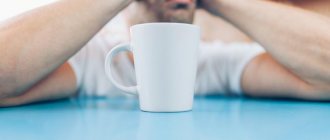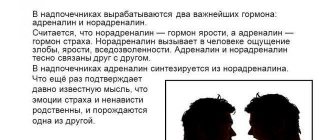How Anxiety Changes Your Mind
Worry not only makes you feel bad, but it actually transforms the structure and function of your gray matter. This reduces the size of the hippocampus, which is considered the seat of memory. Conversely, it increases the size of the amygdala, the area of the brain responsible for the fear response. This makes you become even more anxious and fearful. Tension, fear and anxiety cause the release of stress hormones and cause imbalances in neurotransmitters, the chemicals that mind cells use to communicate with each other.
Symptoms of a panic attack
Although during a panic attack the heart begins to beat at an incredible speed and there is a fear of dying from this, heart attacks or strokes do not occur. On the contrary, research shows that neurotics have a strong cardiovascular system. But those suffering from panic attacks tend to bypass doctors of all specializations and find the pathology of the organ that causes the attacks. The disease, as a rule, is not detected, and anxiety grows. The body is healthy, but the suffering continues.
Fear hidden inside a person can imitate the symptoms of a wide variety of diseases, so a panic attack is accompanied by one, or more often than not, several signs from a long list. Among these manifestations:
- acceleration of heart contractions, pulse;
- a sharp rise in blood pressure;
- shallow, difficult breathing;
- feeling of general weakness or weakness in the legs;
- dizziness, tremor of limbs;
- sensations of heat or chills, sweating;
- nausea, intestinal upset;
- detachment from what is happening, a feeling of unreality.
The body has wisdom and the ability to help itself. Through a physiological reaction in the form of a panic attack, it gives the opportunity to spill out the negative emotions that have been accumulated for a long time inside. Sends a signal that it is not a diseased organ that requires treatment, but a suffering psyche.
How Meditation Changes Your Brain
This practice has been known for thousands of years to help you relax. It changes the structure and function of your gray matter (but in a healthy, productive way). Regular relaxation not only reduces anxiety symptoms, but also reverses the damage caused by anxiety. Thanks to the latest neuroimaging techniques, these changes can be monitored and measured. Scientists at Johns Hopkins University conducted more than 18,000 studies of meditation to determine its most effective uses. They concluded that the number one benefit of meditation is anxiety relief.
Other studies confirm that relaxation benefits mental health conditions of all types, including generalized anxiety and panic disorder, social anxiety, agoraphobia, depression, attention deficit hyperactivity disorder, eating and bipolar disorders, and drug addiction.
Here are some powerful ways to meditate that will improve your brain and mental well-being.
How to treat panic attacks at home
If PA, which happened for the first time, has become a phenomenon that repeats with a certain frequency, you need to consult a doctor. First of all, he will check for the presence of actual pathologies of the most important systems of the human body. If they are excluded, and the diagnosis of a panic attack is confirmed, the doctor will prescribe treatment. Most likely, he will recommend an integrated approach - he will prescribe drug therapy and advise you to undergo a course of treatment with a psychotherapist. And he will definitely give advice on adjusting your lifestyle. Then everything depends on the patient - the more he uses techniques that can be used at home to defeat panic disorder, the faster he will bring this victory closer.
As a result of panic attacks, constant anxiety, and stress, a state of chronic tension of various muscles develops: cervical, facial, shoulder, back and spine. And a person rarely notices this condition, because he is in a state of anxiety and anticipation of a recurrence of the attack. Clenched teeth, tense facial muscles, involuntary clenched fists, a stiff neck and back can all cause serious illness. Osteochondrosis, for example.
Important! First of all, a person prone to uncontrollable panic attacks must learn to relax.
There are different relaxation methods. Among them, meditation in the treatment of panic attacks is considered one of the main ones.
Reflections
The main method by which it helps remove fear and anxiety is to get rid of negative thoughts. Breaking the vicious cycle of obsessive-negative thinking is where spiritual practice really shines. Relaxation reduces noise, even in people with lifelong mood disorders. This reduces the tendency to worry and improves control over random unwanted thoughts.
It can change the way your brain responds to stress. Any habit is difficult to break because of the strong neural pathway that is created through constant repetition. Most of us have about 50,000 thoughts every day, mostly negative. Luckily, your brain has an infinite capacity for change called neuroplasticity.
Meditation teaches you to look at your thoughts in different ways. You will be able to recognize and stop “mental time travel”—worrying about the future and ruminating about the past. Instead of following an anxious thought down the path of all possible negative outcomes, you will learn to recognize it for what it is—one thought—and then let it go. And by creating a new thought pattern, you train your brain to be less anxious.
Other methods
The use of meditation to calm the nervous system and get rid of panic attacks is directly related to methods such as mindfulness and proper breathing, which themselves can also play a significant role in getting rid of the disease, especially if all these methods are combined with physical activity. A little more about these three methods.
Mindfulness
During an attack and before its approach, awareness is almost absent; fear subjugates logic. To slow down and completely stop the flow of panicky thoughts, you cannot do without awareness. What does it mean? Mindfulness begins with understanding that a panic attack is not dangerous for a person. That its manifestations do not harm the body, much less lead to death. A panic attack does not make a person go crazy. He is convinced of the correctness of these statements from his own experience during almost every attack. And this knowledge must be applied in time.
Between attacks, you should try to use mindfulness to control intrusive thoughts. It is worth finding out whether the anxiety has a real reason. If there is a problem, then energy needs to be directed towards solving it. You need to convince yourself that it is impossible to solve a problem by simply constantly thinking about it. If it is obvious that obsessive thoughts have no rational basis, you need to set yourself to ignore them.
It’s also not worth fighting obsessive anxious thoughts. If you develop indifference to intrusive thoughts, they will cease to have a strong emotional impact. You can learn to observe them as if from the outside, without getting involved, like an outsider who has no problems.
You can learn more about psychological techniques for dealing with panic conditions on the page of psychologist Nikita Valerievich Baturin.
Breath
When performing breathing exercises, you need to focus on exhalation, since it is during exhalation that relaxation occurs. Before the breathing exercise, you need to relax your facial muscles and straighten your chest. You should try to pass air into the stomach, into the diaphragmatic region, and not into the chest. Inhale, count to five and exhale slowly. You need to focus on the rule that the inhalation time should be equal to a third of the exhalation. After counting to three, breathe in the air again. You need to repeat the exercise at least five times.
You can breathe through your mouth or nose, without tension or intermittency. inhalation and exhalation should alternate smoothly. After the fifth cycle, the breathing rhythm will be established, you can stop influencing it, just observe. Throughout the day, you should try to repeat this exercise and monitor your breathing. During inhalation, resources are mobilized and the blood and organs are filled with oxygen, and exhalation gives relaxation and relieves tension. The stronger the concentration on breathing, the stronger the relaxation effect.
Physical exercise
Exercise is an excellent remedy for anxiety disorders. To do them, you don’t have to go to the stadium or gym; a lot can be done at home. For example, stretching exercises. They relieve muscle tension, improve blood flow, and help with stress. Yoga gives the same effect.
Moderate aerobic and strength exercise is beneficial. When swimming, water becomes an additional relaxing factor. And the combination of physical activity and fresh air is beyond competition. Walking, jogging, skiing, cycling - any physical activity trains not only the muscles, but also the nervous system.
When you exercise, your body releases endorphins, which are also called joy hormones. There is a feeling of mild euphoria. In addition, by spending energy on physical exercise, the body deprives a panic attack of energy supply.
Meditation for panic attacks in combination with other methods of self-treatment at home will help if at the same time a person changes his lifestyle and gives up habits that destroy the body. In combination with the recommendations of a doctor and the help of a psychotherapist, all these measures can permanently rid a person of debilitating attacks of fear. You just need to find the strength and will to do this regularly and patiently wait for the results.
Meditative balances. Chemical substances
No one knows for sure what is causing the alarm. Risk factors include your underlying personality type, emotional trauma, and even your genes. There is also evidence that anxiety may be caused by an imbalance of brain chemicals caused by severe or prolonged shock. The practice of meditation helps restore an optimal balance of neurotransmitters.
It increases GABA (gamma-aminobutyric acid) levels, which is essential for feeling happy and relaxed. Feelings of restlessness, slight stress, and fear are common signs that you have low GABA levels. Meditation lifts your mood by increasing the amount of serotonin, another neurotransmitter vital to happiness. Reduces cortisol, a stress hormone which, in excess, significantly contributes to anxiety, depression, sleep disturbances and memory loss.
Meditation creates a healthy brain
The gray matter of people who regularly engage in spiritual practice shows:
- measurable increases in cell number, hippocampal volume, and cortical thickness.
- Conversely, the size of the amygdala, an area of the brain associated with fear, anxiety and stress, decreases in size and becomes less reactive.
- blood flow to the mind is increased, neural connections between different cortical areas are improved, and neuroplasticity is enhanced.
- Protecting you from age-related mental disorders, including Alzheimer's disease.
Meditation reduces brain inflammation
Cytokines are chemical messengers that regulate your immune response. Their elevated levels are responsible for chronic aggravation, including brain inflammation, and are associated with anxiety, depression and other mood disorders. Meditation reduces it, up to the level of modifying the expression of pro-inflammatory genes.
You would think that changing heredity would take a long time, but measurable transformations are found after eight hours of meditation. Mindfulness is one of many styles of exercise. Research finds it particularly beneficial for anxiety, even more than other forms of exercise. Good for a beginner as it is easy to do, effective and does not require any special training to get started.
This is a meditation of choice for people who regularly experience unusual levels of stress. Those with high workloads, including Wall Street brokers and Silicon Valley entrepreneurs, rely on it to avoid burnout and maintain their mental edge. US Marines use caution to reduce overall shock, reducing the effectiveness of PTSD and increasing productivity.
Optimize your nutrition
Diet is part of relaxation techniques to relieve anxiety. You should cleanse your kitchen of some harmful ingredients that can affect your well-being, such as alcohol, refined sugar, or caffeine. Also, try to stick to a meal schedule to avoid hunger stress.
It is important to provide your body with mood-boosting supplements such as vitamin B6, vitamin B5, vitamin C, zinc, pantothenic acid, magnesium and other essential minerals and nutrients.
Getting Started: Breathing Meditation
Just 10 minutes a day is advisable. According to Lev Babauta, founder of Zen Habits, even as little as 2 minutes a day makes a difference because it will help build a meditation habit you can stick with. Start with basic breathing practice. With regular practice, it will train your brain to stop jumping around and focus on the present.
Here's how it's done:
- Sit quietly with your eyes closed.
- Breathe normally and just notice it.
- Telling yourself “inhale, release” helps hold on to other ideas.
When you notice a random thought, simply name it “thought” and gently bring your attention to your breathing. Most people new to meditation mistakenly believe that if they had thoughts while practicing, they failed. But the goal of practice is to completely clear your consciousness. Instead, the task is to simply notice ideas as they arise and gently push them aside.
Guided meditation for anxiety
If relaxation offers so much, you might wonder why everyone doesn't do it. Spiritual practice is one of those things that falls into the “not hard, but not easy” category. Silence of the mind—sometimes aptly called the “random image generator”—is no easy task!
Unfortunately, many people give up on self-medication because they can't calm their thoughts and aren't sure they're doing it right, or they're not getting the results they were hoping for. But with guided meditation, you don't have to go it alone. You can follow along with an experienced teacher who will lead you to a relaxed, trance-like state.
Organizational aspects
- It is better to practice in silence and solitude.
- Get rid of clutter . The room or part of the space for meditation for anxiety should be clean and free of debris (lack of oxygen and space will lead to increased anxiety).
- Adjust the information flow. A few hours before practice, go on an information diet - don’t watch TV, don’t scroll through your Facebook feed, don’t discuss with your friends the number of victims at the Baikonur space station.
- Make the practice a ritual. Meditate at the same time . Use aroma sticks or essential oils. After meditation, brew some delicious tea or open a window wide, taking a deep breath of fresh air and saturating your body with oxygen. Come up with some kind of sequence so that you are drawn to study, and not suffer and worry.
Moving
One of the simplest, most accessible moving exercises is considered thoughtful walking. For a unique relaxation experience, try walking the maze. There are a surprising number of intricate paths open to the public.
There are structured moving meditation practices - tai chi, qigong, yoga or any of the martial arts. Note that you can train yourself to be focused when performing any activity.
(Think of the classic “wax, wax” scene in The Karate Kid, where car waxing becomes a mindfulness meditation). You can slowly eat, make tea, wash dishes or brush your teeth.
↑ Autotraining
This relaxation method will teach a person to value himself and give him confidence in his own abilities. Auto-training refers to the repetition of any phrases or sentences that help to reassure oneself that any problem can be solved. Phrases should convince, give a sense of self-sufficiency (something like “I can overcome everything”, “I will succeed”, “I can handle it”).
On a note! To make auto-training more effective, you can sit in front of a mirror - then you will get the impression that you are having a conscious conversation with your interlocutor. This will help give you more confidence.











